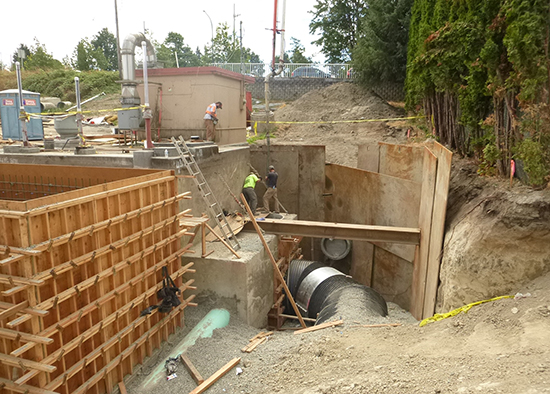|
Subscribe / Renew |
|
|
Contact Us |
|
| ► Subscribe to our Free Weekly Newsletter | |
| home | Welcome, sign in or click here to subscribe. | login |
Construction
| |
 |
January 27, 2020
Best in state: Gold award
Complexity
Otak

Project: Hayes Street regulator and CSO controls
Client: City of Everett
The Hayes Street regulator and CSO controls project was designed to address the number of combined sewer overflow events the city of Everett was experiencing at specific outfall pipes that direct CSOs to the Snohomish River. The Hayes Street project involved extensive modifications to existing pipes and structures composed of large flow-control structures and a new network of large-diameter sewer pipes.
Otak, serving as the project’s prime consultant, oversaw a complex hydraulic analysis that involved modeling flow characteristics of multiple pipes and control appurtenances using both single event and continuous time series event storms. Components used included two existing flow-regulator structures, flows from an existing lift station, an existing siphon headworks structure, and three independent outfalls to the Snohomish River.
Adding complexity to Otak’s effort was the project’s relatively small site. The siphon headworks facility lies 12 to 15 feet below East Marine View Drive (the main road), with only a steep, one-lane access drive down to the facility.
Hayes Street extends from this main road down to a dead-end alley that abuts the city’s siphon headworks site. Hayes Street was the only public road access in and out of the site, but using it as the main construction accessway for the duration of the project would have significantly impacted adjacent businesses, presented added public safety risks and increased the contractor’s traffic control costs.
To minimize these impacts, the Otak team designed a temporary access road across a city-owned parcel that was used as the principal construction access road.
While construction was underway, normal dry-weather flows had to be maintained and provisions had to be made to handle high flows that occur during heavy rains. Otak’s team designed a complex sequencing plan that allowed building the improvements while bypassing or transferring flows to already-constructed and accepted improvement elements. Additionally, Otak’s design specified high-flow requirements for the contractor to provide additional standby pump capabilities when the forecast threatened rain and during critical portions of construction to avoid spills and construction-related CSO events.
The project design enhanced the performance of the existing network and achieved the city’s goal of reducing CSO events to fewer than one per year.
Other Stories:
- National finalist: Platinum award
Transportation
Jacobs Engineering Group - Inclusion awards
- Best in state: Gold award
Successful Fulfillment of Client/Owner Needs
Stantec Consulting Services - Best in state: Gold award
Successful Fulfillment of Client/Owner Needs
Reid Middleton - Best in state: Gold award
Successful Fulfillment of Client/Owner Needs
Otak - Engineer of the Year
- Best in state: Gold award
Social, Economic and Sustainable Design
Mead & Hunt - National finalist: Gold award
Special Projects
Hart Crowser - National finalist: Gold award
Transportation
GeoEngineers - National finalist: Gold award
Structural Systems
Magnusson Klemencic Associates - Best in state: Gold award
Unique or Innovative Applications
Shannon & Wilson - National finalist: Gold award
Waste and stormwater
Carollo Engineers - Best in state: Gold award
Future Value to the Engineering Profession
HWA GeoSciences


